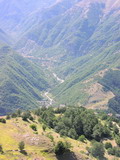The sheet 348 "Antrodoco" at 1:50,000 scale

The research has been divided into different activities: geological mapping and sampling of the sequences and analysis, interpretation and processing of the collected data. Up to now, about 70% of the field survey at 1:10.000 scale was completed and more than 2500 thin sections of rocks were prepared and analyzed. The Sheet 348 “Antrodoco” lies in the Central Apennine and its peculiar geological interest is linked to the presence of sedimentary successions that contain palaeoenvironments ranging from the basin to the inner carbonate platform, with all the transitional facies, and with an age ranging from the upper Triassic to the Neogene. The sedimentary lithotypes show a tectono-sedimentary evolution indicating a complete orogenic cycle.
 The different sedimentary successions crop out in 5 distinct structural units, in which the sheet can be divided. Four of them are separated by relevant fault lines. In addition, within the sheet there are some smaller low-flat areas occupied by Quaternary continental deposits.
The different sedimentary successions crop out in 5 distinct structural units, in which the sheet can be divided. Four of them are separated by relevant fault lines. In addition, within the sheet there are some smaller low-flat areas occupied by Quaternary continental deposits.
The first area (Monti Sibillini Unit) occupies the whole western part of the sheet and is bounded towards the E by the Olevano-Antrodoco-Posta-Monti Sibillini overlapping line. This line has a N10-20 average trend.
This area consists of trending meridian ridges with accentuated morphology and is characterized by heights that exceed the 2000 m above sea level. The stratigraphic succession starts with carbonate platform deposits evolving to escarpment/basin ones and it includes all the terms known from the Calcare Massiccio of lower Jurassic up to the Cerrogna marls of Miocene.
 The second area (Monte Nuria Unit) occupies a narrow parte of the southern sector of the sheet. This area is bounded towards the N by the Antrodoco fault and to the W by the Olevano-Antrodoco line. This unit crops out mainly in the adjacent Sheet 358 “Pescorocchiano”, to the south.
The second area (Monte Nuria Unit) occupies a narrow parte of the southern sector of the sheet. This area is bounded towards the N by the Antrodoco fault and to the W by the Olevano-Antrodoco line. This unit crops out mainly in the adjacent Sheet 358 “Pescorocchiano”, to the south.
This area is characterized by ridges descending from S and W to the N and to E, towards the Velino Valley. The highest altitudes reach the 900 m above sea level, while the lower ones reach the 450m above sea level, that represent the lowest elevation of the whole sheet. The area is characterized by post drowning carbonate platform condensed Scaglia formation (the underlying margin to inner carbonate platform deposits crop out only in the Sheet 358 “Pescorocchiano”). The condensed succession is overlapped by Miocenic carbonate ramp deposits passing to upper Tortonian-lower Messinian foredeep sediments (clay-marly unit and Antrodoco flysch). The sedimentary cycle ends with widespread Pleistocene continental breccias unconformably resting on the substrate.
 The third area (Monte Giano-Monte Gabbia Unit) occupies most of the southern and central part of the sheet and is bounded to the N and the NE by the M. Gabbia-M. Cagno-M. Calvo thrust fault, and to the SW and the W by the Antrodoco fault and the Olevano-Antrodoco line.
The third area (Monte Giano-Monte Gabbia Unit) occupies most of the southern and central part of the sheet and is bounded to the N and the NE by the M. Gabbia-M. Cagno-M. Calvo thrust fault, and to the SW and the W by the Antrodoco fault and the Olevano-Antrodoco line.
This area is characterized by Apennine trending ridges, with remarkable morphological throw along the southern and western edge and gentle drops towards N-NE and inside the unit itself. The maximum heights reach the 1800 m above sea level. The area is characterized by a rather diversified succession and in some places very peculiar sedimentary deposits. These are related to different environments ranging from the inner carbonate platform to the marginal areas of the carbonate platform system, including also its outer portions, relating to a slope s.l. Starting from the upper Cretaceous the platform passed to terms of lowered step-slope because of a tectonic collapse. In the Miocene time this area evolved in a carbonate ramp environment. Also in this area the sedimentary cycle ends with widespread Pleistocene continental breccias, unconformably resting on the substrate, and cropping out in the southern part of the unit.
The fourth area (Gran Sasso–Cittareale Unit) occupies the central-eastern and the central-northern part of the sheet and is bounded to the S-SW by the M. Gabbia-M. Cagno- M. Calvo thrust and to the W by the Olevano-Antrodoco line. This zone passes toward NE to the Acquasanta-Montagna dei Fiori Unit without particular tectonic disruptions.
The area is characterized by a long ridge developed with an Apennine trend, with maximum heights reaching the 1500 m above sea level; it represents the westernmost part of the Gran Sasso-M. S. Franco chain. The succession is characterized initially by carbonate platform sediments (Calcare Massiccio) and successively by slope/basin deposits as in the Monti Sibillini Unit.
The fifth area (Acquasanta–Montagna dei Fiori Unit) occupies the whole north eastern part of the sheet and is geologically the direct prosecution of the Gran Sasso–Cittareale Unit. The area is characterized by a long Apennine trending ridge with heights that reach the 1600 m above sea level. Within this unit the terrigenous Tortonian-Messinian lithotypes (upper part of marne con Cerrogna, marne a Pteropodi and flysch della Laga) outcrop. These deposits represent the foredeep evolution of the slope-basin succession of the Gran Sasso–Cittareale Unit.
